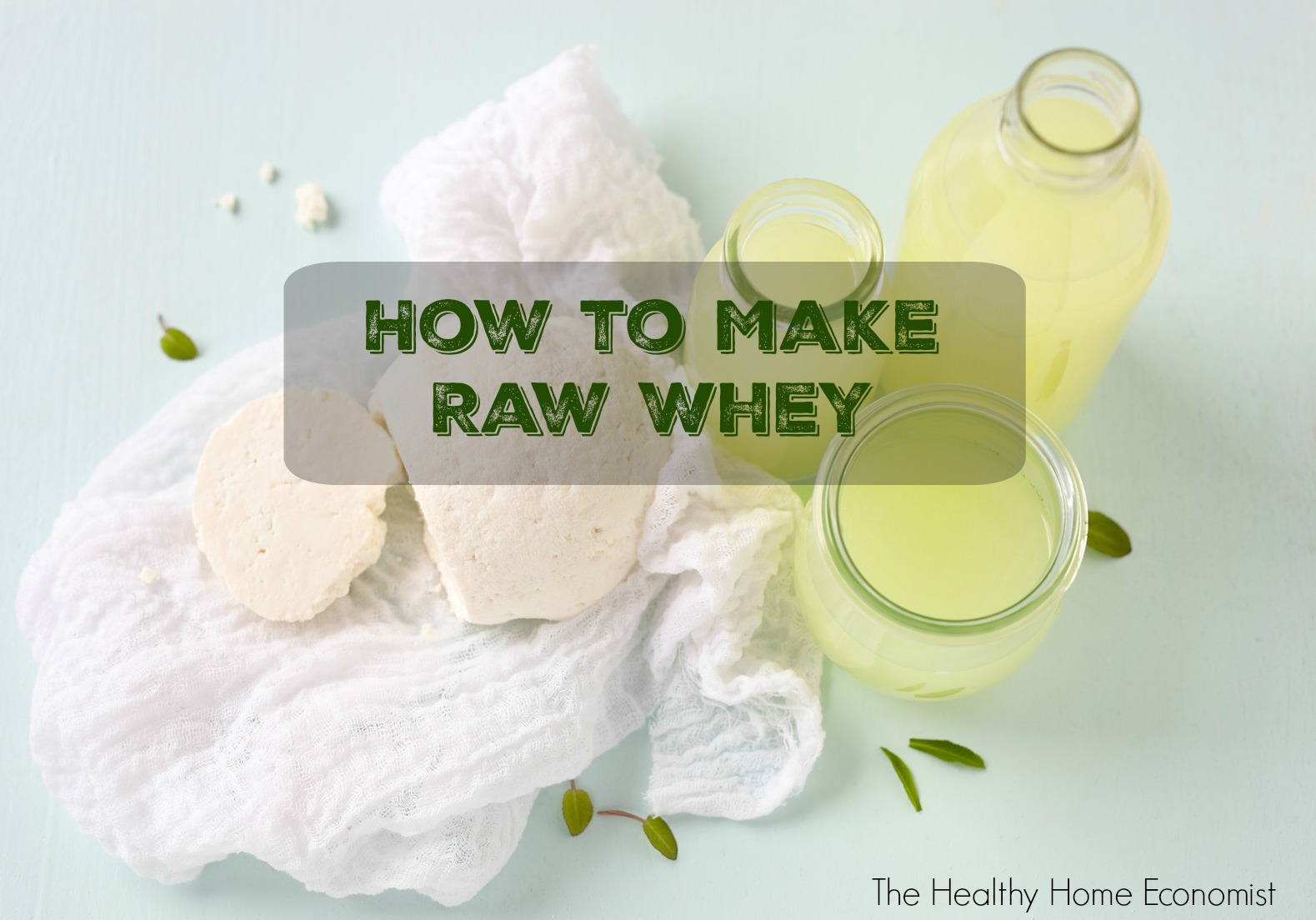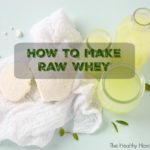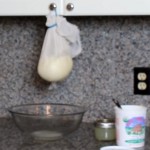How to make raw, enzyme and probiotic-rich liquid whey to use as a starter culture for all your home fermentation needs.

Do you know how to make whey from yogurt, kefir or raw milk?
A by-product of this simple technique is healthy homemade cream cheese that is loaded with enzymes and probiotics.
The recipe below describes how with visual instructions via video demonstration!
Making homemade baby formula? I recommend using this “quick whey” no straining method as the fastest and easiest approach.
How to Make Whey the REAL Way
Making real, liquid, nutrient rich, unadulterated whey in your own kitchen is a MUST step for any traditional cook to learn.
Without whey in its whole, liquid form, many other traditional recipes cannot even be attempted. You cannot buy whey from the store except in a denatured, unhealthy, powdered whey form. It is worth your time to learn what I show you in the video below.
Other video lessons on this blog show you how to use this whole food form of whey to make many delicious, healthful recipes for your family. Whey as made in the video demo below will keep up to 6 months in the refrigerator in a sealed mason jar.
If you absolutely have no access to farm fresh milk to make whole, unadulterated, enzyme rich whey, then you can use plain, organic yogurt brand from the store instead. Here are tips on how to spot the best yogurt brands.
The process is basically exactly the same thing as shown in the video.
You won’t get nearly as much whey using yogurt as clabbered, farm fresh milk, but at least you can get enough to get you started.
Wonderful Whey and REAL Cream Cheese
The raw, enzyme-rich cream cheese I make in the recipe video below is fantastic on a sprouted or sourdough bagel for breakfast. Don’t buy the Ezekiel sprouted muffins as they contain soy. This low-carb bagel recipe is another great one to try.
If you prefer to buy, these sourdough bagels are available for shipping freshly made to your door.
To make, just take your cream cheese left over from making liquid whey and add a few strawberries and a dash of dark maple syrup to taste. Mix together by pulsing a few times in your food processor. This wonderful, fresh, REAL strawberry cream cheese will last one to two weeks in the refrigerator. Another wonderful use for this healthy raw cheese is to make an easy no bake cheesecake.
No access to raw milk where you live? No problem. Check out this recipe plus video on how to separate whey from yogurt purchased from the store.
Cloudy Whey vs Clear Whey
No matter whether your whey turns out cloudy or clear, it is safe and fine to use in all your favorite recipes. This article explains why sometimes whey is cloudy compared to its usual golden color.

Raw Whey Recipe
How to separate raw, liquid whey from clabbered milk. The process also creates probiotic rich cream cheese.
Ingredients
- 1 quart raw milk preferably grassfed
- 1 large glass bowl
- 1 large rubber band
- 1 white dishtowel
Instructions
-
Allow the raw milk to sit on the counter for 1-3 days at room temperature.
-
When the milk separates into curds and whey (transforms into clabbered milk) you are ready to proceed. Note that the fresher the raw milk and the colder the temperature of your house, the longer it will take the raw milk to clabber.
-
Line a clean, large glass bowl with a clean, white dishtowel that isn’t too thick. Cheesecloth will also work, but the holes in the mesh must be very small, else the milk curds will pass through.
-
Gently pour the clabbered milk into the middle of the dish towel. Gather up the ends and fasten with a rubber band. Attach to a knob on an upper cabinet in your kitchen as shown in the picture.

-
Let the raw whey drip into the bowl underneath. This process will continue for an hour or two.
-
After the dripping stops, gently take down the hanging bag and place it into a clean bowl. Scrape out the raw cream cheese that is inside the bag, put in a container with a lid and refrigerate.
-
Pour the liquid whey from the dripping bowl into a glass mason jar, afix the lid and refrigerate.
-
Refrigerated, raw cream cheese will be good to eat for about a week. Raw whey will last several months refrigerated.
Recipe Video
How to Use Whey in Recipes
How to Make Ricotta Three Ways (plus Video How-to)
Perfect Probiotic Cottage Cheese
Cheese Making: Common Problems and Solutions








Hi Gail, I have no idea how much liquid whey equates to processed protein powders. Protein powders are always denatured by definition. They are a very bad idea to consume and no brands are recommended by the WAPF for any reason at any time. They quickly deplete vitamin A stores in the body and are extremely hard to digest. Most are loaded with MSG also .. formed during the processing (not added of course).
Hi Sarah,
My husband drinks undenatured whey protein isolate, 100% natural. So comparatively speaking it is healthier, but when I make this healthy fresh whey for him, (and I take the cream cheese for myself :-)) how much of it should he consume when a scoop provides 26 grams of protein. Also, if I make a cheesecake with the cream cheese, does this preserve the nutritional value of the cheese? The enzymes will die, right? Thank you so much, you are awesome!
HI Stacey, you can make liquid whey and cream cheese from plain whole milk yogurt from the store. You just won’t get as much liquid whey as you would with clabbered milk.
This is super interesting, but also incredibly frustrating for me! It is illegal to sell raw milk in Canada, and I don’t feel comfortable breaking the law. I don’t even want to try inquiring around to find a potential raw milk source. I can only do the best I can, and that is Organic whole milk from a local source.
Hi Kerry,
Target and Walmart both carry large 1-2 gallon glass jars at least in my neck of the woods. So glad you are getting off the raw vegan lifestyle and finding your way back to traditional foods! 🙂
thanks for your awesome videos! i'm transitioning from a raw vegan lifestyle and you make nourishing traditions very "user friendly"! ; ) can you please suggest a good source for the large 1 gallon & 2 gallon glass jars? we own a dairy supply company in salem, oregon, so i have lots of options for good, clean pastured organic raw milk from beautiful jerseys from several of our customers. i just need some good jars to bring the milk home in. : ) thanks for all you do … i've had a sarah video marathon tonight & i feel armed, knowledgeable & ready to try many new things. thank you!!!!
Hi Sadie, clabbering always works – its just the consistency of the cream cheese and the whey may vary a bit from batch to batch. Sometimes the whey is cloudy, sometimes clear. This is the nature of traditional cooking.
Hi Sarah,
Just found your video. I had tried to make whey a few days ago from raw milk that had soured in the fridge. The curdy part looked clabbered, but what I thought was whey was very milky looking. I left it out 3 days at about 70 degrees and it never seemed to change from how it came out of the fridge. Also very sour and slightly bitter.
Now trying again with fresh milk on the counter. We had dipped some of the cream off for pumpkin pie. There's still some cream on top, but not a thick layer.
Will it still work, but with less cheese left over or do I need more cream to make the process work?
Thanks, love your video.
Sadie
Hi Sarah, thanks for this video. I just completed my second batch of cream cheese and whey, yesterday. And I must say the second batch turned out even better than the first (and that batch was pretty good.) I let the milk sit out for an extra couple of days this time and that seems to have made a really nice difference, giving the cheese a bit more of a tang.
I also reserved out 1/4 c of the clabbered milk to start the process of making buttermilk.
I can't believe how easy this was… I'll never buy store bought cream cheese again. Or buttermilk for that matter.
UPDATE! So my goat's milk did clabber – I put it in my laundry room where it stays pretty warm, and in a day it clabbered pretty well. So then I used some of it to make the homemade cold breakfast cereal, and the rest I used to see if I could make liquid whey and cream cheese. It worked! Goat's milk does clabber, maybe it just takes longer than cow's milk to separate. But for all the goat's milk drinkers out there – you can make this! I haven't tasted it yet, but it looks just like yours!